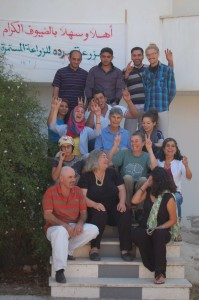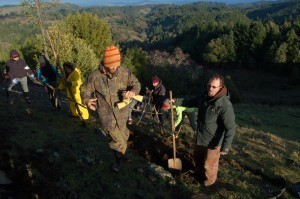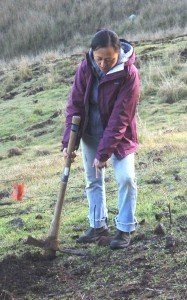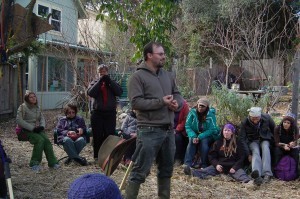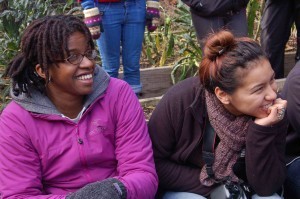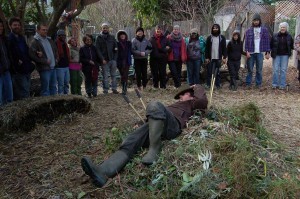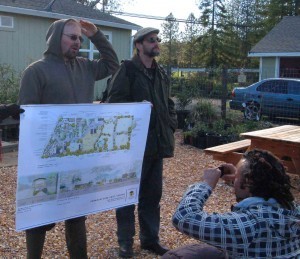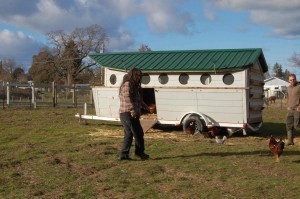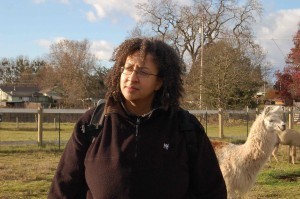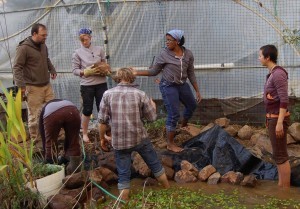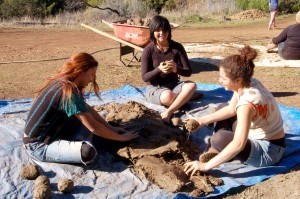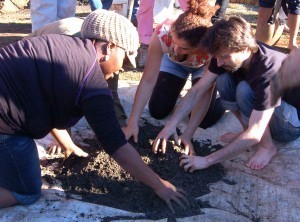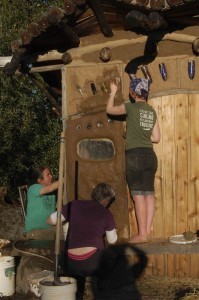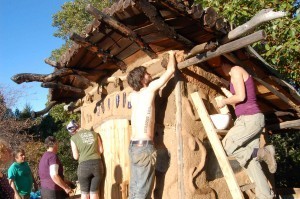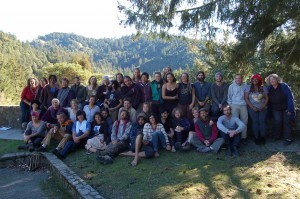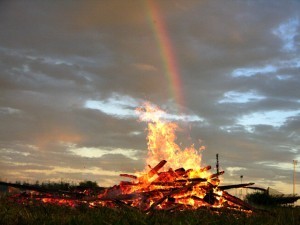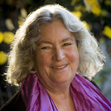Starhawk's Blog, page 2
November 23, 2013
Permaculture in Palestine
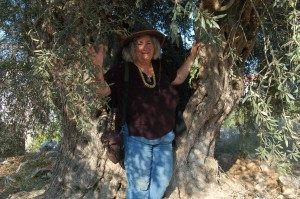
Happy to be in Palestine!
I’m shamefully behind on this blog, and my only real excuse is that I haven’t been just idling away my time watching old episodes of ER from the nineties, I’ve been writing. A rewrite of the screenplay for The Fifth Sacred Thing—that took a big chunk of the summer! And then I’ve finished a second draft of the sequel. Don’t get too excited—there’s still a third and possibly fourth or fifth to come, but definitely Progress Has Been Made!
And a few other things—like putting together our new IndieGoGo campaign for Diversity Scholarships for our Earth Activist Training! Check it out and please share it with all your friends and social networks. We need your help to bring the skills and tools of permaculture to the communities who most need them—and to do that, we’ve got to train people who come from those communities.
And speaking of Earth Activist Training, I taught two of them back-to-back, one in Vermont, one in Palestine. I’ve been wanting to blog about them both but I’ll settle this morning for uploading some of the pictures and experiences from Palestine. Because tomorrow I’m off to Cuba for the International Permaculture Convergence and after that I’ll have a whole new set of adventures to blog about, I’m sure.
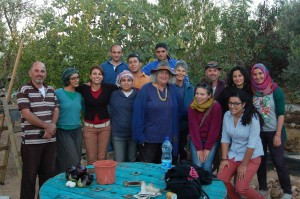
Our course!
Teaching permaculture in Palestine has been a long-time dream of mine, and a few years ago I was scheduled to teach at the Marda Permaculture Farm with its founder, Murad Al-Khufash. But on that trip, the Israelis, who control all the borders into Palestine, would not let me in because of my history of working with the International Solidarity Movement, which supports nonviolent resistance against the Occupation.
But two years ago, after the International Permaculture Convergence in Jordan, I did get in. So I was hopeful (‘confident’ would be an overstatement) that I could get in again. Jillian Hovey, an experienced permaculture teacher who works internationally, agreed to co-teach with me, and I was happy to know that someone was available who could anchor the course if I didn’t get across.
I left Jericho, Vermont and flew a convoluted route into Amman, came across the border from Jordan the next day and spent six hours sitting and waiting—just a little taste of what Palestinians go through all the time—but I had brought a very good book and eventually I got in! Another bus ride to Jericho—making me one of probably very few people who have travelled directly from Jericho to Jericho, and a long taxi through the dry and stony hills of Judea, and I arrived in Marda.
Marda is a sweet village nestled in the arms of terraced olive groves and looking out over the valley to villages high in the hills beyond. Ancient olives with thick, twisted trunks, centuries old, march along the stone-buttressed terraces, mile after mile of human-sculpted landscape. It has one main street, a couple of shops, a mosque, and many solid, substantial houses built of stone or stone-faced concrete. Young boys kick soccer balls down the street, old men sit and talk, women in long coats and headscarves walk gracefully erect, arm in arm, and everyone seems to know everyone else. It seems prosperous, peaceful, timeless.
But Marda lies just below Ariel, the fourth largest Israeli settlement, a gated community of more than 18,000 people. You can hike uphill to the razor-wire topped fences that close off the area where Murad herded goats as a boy and played soccer. From the village, you can ignore its presence—until you look up. Then there it is, a line drawn on the skyline.
The course is held in a white house on the far end of the main street. Like a lot of Palestinian houses, it’s all white concrete walls and synthetic stone floors, very clean and polished. There’s a kitchen and a small living room area for eating and relaxing, a big bedroom for the women and another for the men, and a small room that Jillian and I share. The classes are held on the roof, where they’ve set up a tent to shade us from the sun.

Jillian Hovey and students.
We have a small course of seven women and five men—two internationals and the rest are Palestinian. Tobias who has been working with Jillian at Tamera Ecovillage in Portugal, grew up in Scotland. The Palestinians are all young professionals. We have agricultural engineers, two architects, a public health administrator, a nutritionist, and one of the organizers of the Slow Food movement in Palestine. They are all very bright, knowledgeable, warm and friendly, and willing to help. Murad’s wife cooks us a fantastic lunch every day, but the students prepare breakfast and a light dinner and share cleaning chores—both the women and the men!
I’m a bit worried, the first day, as to how our students will take to my teaching style, which involves a lot of games, jokes, sing-alongs, and the odd trance. Our Earth Activist Trainings are rooted in earth-based spirituality, and I generally weave a lot of grounding and awareness techniques not to mention songs, drumming and a few guided visualizations into the mystical heart of soil fungi. Murad is a devout Muslim, as are some of our students. Among the women, only one wears the hijab, the head-scarf, but the some of the men are scrupulous in observing the daily prayer-times and the Friday visit to the mosque.
But I start by teaching some basic grounding and awareness techniques, and send everyone out to observe the nature around us for a short time. And I’m pleased to discover how open everyone is to the exercise, and the depth and beauty of their observations. So each morning I send them out to observe some new aspect of the natural world: patterns, water flows, energy exchanges, etc. And by a few days into,the course, we’ve translated the “Earth my body” chant into Arabic!
[image error]
“Earth My Body” in Arabic

Building an A-frame to find contour.
In the afternoon, we walk down through the village to the permaculture demonstration farm Murad has established. Again, I’m a bit worried about our engineers. They speak the least English of any of our crew, so it’s hard for me to check in with them directly. The farm has an abundance of young fruit trees, herbs and medicinal plants growing in profusion, but we’re between seasons for most vegetables and the summer beds are looking a little ragged. Two of engineers, Ahmed and Hisham, make a beeline for one pomegranate that has some spots on the leaves. They nod their heads and make knowing comments.
Meanwhile, Sultan, one of our architects, tells the group he doesn’t think the farm design embodies harmony. It is true that Murad has taken to heart the permaculture principle that waste is a resource, and old tires figure heavily in the design. He uses them to fence out the wild pigs that roam at large around the village. The Israeli authorities won’t allow the villagers to trap or shoot them, and they ravage the gardens and cause erosion problems—just as they do in the Cazadero hills where my own land lies. But a combination of old tires and barbed wire keeps them out.

Filling earth bags for natural building.
I tell the group what I see in at the farm—the diversity of trees and food plants, designed so that if one crop doesn’t do well others will fill in. The many levels of planting, from the upper-story trees to the smaller bushes, the low annuals and perennials, the ground covers—a classic forest garden. The way Murad has integrated chickens who clean the ground when he lets them forage and live in a naturally-built cob chicken house. I sense they are looking at the garden with new eyes.
My drum is an instant success. It’s a doumbek, the traditional Middle-Eastern drum, and while I don’t speak much Arabic I do speak drum. The rhythms I have learned back in California come from here and are completely familiar to our students. Duja snatches the drum and begins to play—then hands it over to Sultan. While we’re doing the supper dishes, someone puts on some Palestinian music and Hisham and Ahmed begin to dance the dabka, the traditional folk dance. Hisham is a big bear of a man with a shy smile and Ahmed is muscular and hefty and befits a farmer, but when they dance they are light on their feet and graceful. The women get up and I follow Lina’s steps to learn the dabka myself while Duja switches the music to Palestinian hip-hop. We’re all laughing and dancing—and that sets the pattern for most of our free time.
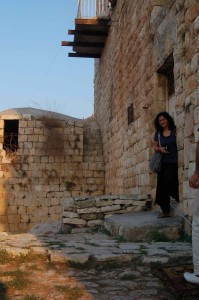
Lena at a historic building.
There are many highlights of our time. Sahar, also an architect, works for an organization called Riwaq that preserves historic Palestinian buildings. She takes us to visit one of their projects in Marda, a centuries-old Ottoman castle that actually belongs to Murad’s family. Half of it is in ruins, half of it is now inhabited by families who throng out into the courtyard and press fresh-picked almonds into our hands. We prowl around the old stones and climb up to the top floor where a beautiful, arched room hints of the artistry and luxury of the rulers. Riwaq is working to shore up the crumbling walls and secure the structure while respecting its integrity. After our visit, we are offered tea at Murad’s family home, another ancient building where his twin brother and family now live with his mother. We drink tea and eat cookies on a high terrace with a long view over the valley and the olive groves. As long as we don’t look behind us, where Ariel looms overhead, we can bask in the peace of the sunset and believe that everything is fine.
We also hold an open day, and people come from all over the West Bank to listen to us talk about permaculture and hear lectures from some of the local experts on everything from Green building to beekeeping. There is a growing green movement in Palestine, which draws from their strong cultural connection to the land. They’ve been tending the land for thousands of years, using many practices we now adapt in permaculture, including the idea of an agriculture primarily based on tree crops: olives, almonds, figs.

Ariel looms above…
And we discuss how to do permaculture under Occupation, when so much of what you might want to do is prohibited, when someone else controls your water supplies—and takes 80 per cent of the water to supply the illegal settlements—as well as your markets, your freedom to move and travel, your freedom to simply live as your ancestors have always lived. This trip is so different for me—I’m not confronting soldiers or challenging check points or standing in front of tanks. Nothing is being blown up around me, and no one is firing bullets into the walls at night while kids do their homework, like in Gaza when I was there. Everything seems so normal, so relaxed.
Just don’t look up!
Because it’s always there, the Occupation. In the cracks in the walls, where during heavy rains Ariel releases floods of raw sewage down on the village. Many of the settlements neglected to build sewage treatment plants, and simply dump their wastes down on Palestinian fields. It’s there in the stories the guys tell as we drink tea in the evening, laughing and joking about the times they’ve been arrested for nothing, about beatings and jail cells and standing outside while the Israeli soldiers blow your house up.
It’s there on our day off, when I hop on a Settler bus to Tel Aviv to go and visit my Israeli friends, so aware that my students, these intelligent, educated, warm and wonderful new friends, can’t come with me and simply go to the beach.
But it is good to see my friends, old friends from many years and new ones like Barak ben Hanan, an Israeli permaculturalist who gives us a tour of some of his projects in Tel Aviv, from a community garden to a roof garden on a school for severely disabled children with a very impressive system that recaptures water from the air conditioning system and uses it to grow plants.
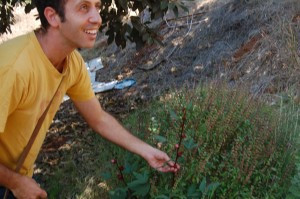
Barak ben Hanan
Good will exists between Israeli and Palestinian permaculturalists, but the Occupation stands in the way of their ability to cooperate and work on common projects. It throws up physical and legal barriers, but more than that, it creates barriers in the mind. Contrary to the myths, Palestinians and Israelis get along quite well as people, or so I’ve found, when they share a common purpose or interests. But the Occupation is always there, looming like Ariel just above your line of focus, an ache in the neck you hardly notice because it’s become part of you, that restriction of motion from not looking up.
I’m grateful for my time in Palestine, for the opportunity to teach there and to learn far more! I hope to go back again, many times, and to continue supporting all those who care for the earth, the people and the future of the land. Thanks to Murad for his vision and years of hard work, to Murad’s family for providing wonderful food and practical help on so many levels, to Lena who administered the course and to Jillian who co-taught with me. And thanks to all of you who have helped in our various fundraising campaigns that make this work possible.
May 9, 2013
The Fifth Sacred Thing Movie: Update and New Video
Making a movie is a long, long process! Often people who have followed our earlier successful Kickstarter campaign or who know we’ve been working on this project for a long time ask me, “When is it coming out?” Well, we’re still a long way from that happy day—we’re in the slow, difficult process of development, which means creating concepts, getting the screenplay just right, and mostly, getting the investment and the financing! But along the way, we’ve created a new video, to quickly explain the story to those who haven’t read the book, and to show off some of the art and music we’ve had created.
Pictures speak louder than words—so here it is:
http://www.fifthsacredthing.com
(There’s a close-captioned version on the website for the hearing-impaired.)
Also on YouTube:
http://www.youtube.com/watch?v=lROCSDQg9WM
What it’s not: It’s not a trailer for the movie, in the sense that a trailer is a selection of scenes to build interest for a movie that’s already been made. We haven’t made it yet—and when we do we still intend to make a live-action, feature film with real actors, not an animation. But until we get the financing to shoot the film, we can’t put together scenes that don’t yet exist. So we’ve exercised our creativity to show you a bit of our underlying concept, together with the art and music we have been able to create thanks to the amazing support we’ve already received. So think of it more as a video calling card, something we can use to introduce the project to investors and potential collaborators.
Please take a look at it, and if you like it, please share it with your friends and your social networks. You can give us your feedback by commenting here or on The Fifth Sacred Thing website.
Credits for the video:
I wrote the narration, the wonderful actress Olympia Dukakis speaks the narration. Olympia has agreed to play Maya in the movie, too!
Philip Wood, our lead producer, created and edited the visuals and did the special effects. The score was written by Joshua Penman of Akara, and mixed by Rena Jones.
The concept art was executed by our stellar crew of artists: Andrew Jones, Jessica Perlstein, George “Geoglyphics” Atherton, Layil Umbralux and Mark Lakeman, Jen Zariat, and also features the original novel cover art by Keith Batcheller.
The video also features the mural “A New Dawn (Naya Bihana)” by Martin Travers, as well as a fantastic piece by muralist Juana Alicia.
We also thank Jay Rosenberg, Hayes Valley Farm, Double Rock Garden, Emerald City Garden, Food Not Bombs, Golden Rabbit Ranch, and The City & County of San Francisco for their contributions to the video.
If you want to help us with the movie, please Like us on Facebook and check our website regularly where we have lots of features and an ongoing blog about the production. We are also happy to accept donations of any amount—the button is on the website. If you are interested in participating more actively or in volunteering for one of our related projects, you can sign up on the website as well. Just pull down the Get Involved Menu and click on Participation Signup.
http://www.fifthsacredthing.com
Yes, it’s a long haul, but we’re all feeling the growing momentum with the spring! Thanks so much for the support you’ve all given us throughout the years,
In gratitude,
Starhawk
April 20, 2013
Permaculture in Palestine
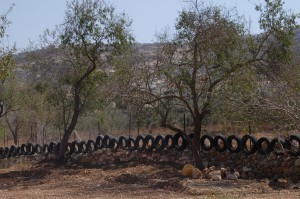
Marda Permaculture Farm
*(Unfortunately, we have had to postpone our course, but I will post the new dates here as soon as we have them!)
The olives are flowering on my land in California right now, just as they are in the olive groves of Palestine. In a few weeks I’ll be heading there to coteach a permaculture course at the Marda Permaculture Farm on the West Bank, together with Klaudia van Gool from England and Murad Al-Khufash, who runs the demonstration farm and who is bringing the tools and insights of permaculture to Palestine.
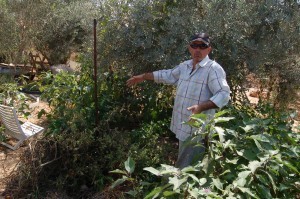
Murad Al-Khufash
It’s so hard, when we look at that part of the world, to feel hope and optimism. Maybe you, like me, sometimes feel overwhelmed and despairing. The structures of oppression seem so entrenched, the obstacles almost insurmountable.
Yet I always find hope in the resilient, creative spirit of the people there.
Permaculture offers a way to support their efforts at survival and regeneration. It offers the skills and insights needed to create true abundance, to heal the land and provide healthy food and build the foundations for justice and peace.
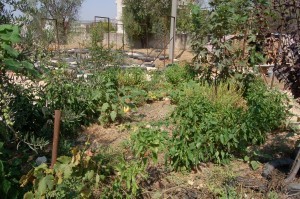
Permaculture polyculture at Marda
If you’ve ever wondered what you can do, here’s an opportunity to contribute to healing and renewal in this troubled region. We need your help for this course to go forward.
We need to raise five thousand dollars to support the costs of the course and to make it available for Palestinians who suffer many economic privations under the Occupation. $400 will sponsor a scholarship for one Palestinian student. Any donation of any amount will help us to make the course happen and help the Marda Permaculture Farm to carry on its ongoing, vitally important work.
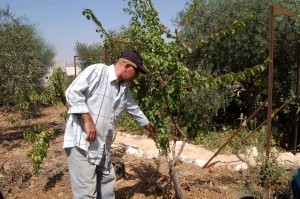
Fruit trees are the backbone of a food forest!
The course is open to internationals, and if you have ever thought of taking a permaculture design course, this is a unique opportunity to connect across cultures and learn both ancient traditions and new approaches. Below is information about the course. The more internationals who join us, the more Palestinians we can serve.
But if you can give something, even little bits add up to a whole lot of hope!
Tax-deductible donations can be made through the Global Village Institute.
Donate online here: http://www.thefarm.org/etc., project to be funded MUST be specified as “Marda Permaculture Farm”. Or log in to PayPal and SEND the donation to ecovillage@thefarm.org. Specify “Marda” in the comments field.
You can also donate by check. Make the check out to Global Village Institute and be sure to earmark it “Marda Farm.” Send it to:
Ecovillage Training Center
The Farm, 184 Schoolhouse Road, PO Box 90
Summertown, TN 38483-0090 US
I’m so grateful for the generosity of this community! I know that I come to you a lot—but you always come through and because of you, Earth Activist Training and our sister organizations have been able to do amazing things, from diversifying our movement to allying with those who are doing cutting-edge work in hugely challenging situations! I’m so proud and thankful to have you on our team!
Starhawk
Earth Activist Training

A garden in a dry land!
From Marda Permaculture Farm:
We are very excited to announce that our upcoming Permaculture Design Course will be taking place next May, 16th-30th , with the renowned international teacher and global justice activist Starhawk as well as the permaculture specialists Klaudia Van Gool and Murad Al Khufash.
Join us! Learn about Permaculture and traditional Palestinian farming whilst experiencing the culture, food, and traditions of beautiful Palestine.
Marda Permaculture Farm seeks to address critical issues in the Palestinian community like food security, health, self-reliance and community empowerment through reviving traditional agriculture and promoting a range of permaculture techniques that support chemical-free, diverse food production in balance with the cultural and biological landscape, while conserving and recycling water, energy, and other resources.
PDC to run 16th-30th May
Languages: English with Arabic translation
A fantastic opportunity to learn Permaculture Design at Marda’s demonstration site and to experience Palestinian culture at its richest.
Marda is an ancient, peaceful stone village nestled in the mountains one hour from Jerusalem and surrounded by olive groves.
The mild climate and rich soil support a great diversity of flora and fauna and being close to the soil here in the Holy Land is a life changing experience.
The course includes 14 nights board in a comfortable house (camping if you prefer) with internet, showers, washing machine etc..
Everyone is welcome to this 14 day event, please contact us to book and for help with travel advice.
For further information, please check:
Website: http://mardafarm.wordpress.com/marda-permaculture-cetificate-may-2013/
Facebook: https://www.facebook.com/groups/MardaPermacultureFarm/
Or send us an email at: mardapermaculture@gmail.com
We look forward to having you with us, and share this fantastic experience together.
With our best regards,
Marda Permaculture Farm
Marda Permaculture Farm
The olives are flowering on my la...

Marda Permaculture Farm
The olives are flowering on my land in California right now, just as they are in the olive groves of Palestine. In a few weeks I’ll be heading there to coteach a permaculture course at the Marda Permaculture Farm on the West Bank, together with Klaudia van Gool from England and Murad Al-Khufash, who runs the demonstration farm and who is bringing the tools and insights of permaculture to Palestine.

Murad Al-Khufash
It’s so hard, when we look at that part of the world, to feel hope and optimism. Maybe you, like me, sometimes feel overwhelmed and despairing. The structures of oppression seem so entrenched, the obstacles almost insurmountable.
Yet I always find hope in the resilient, creative spirit of the people there.
Permaculture offers a way to support their efforts at survival and regeneration. It offers the skills and insights needed to create true abundance, to heal the land and provide healthy food and build the foundations for justice and peace.

Permaculture polyculture at Marda
If you’ve ever wondered what you can do, here’s an opportunity to contribute to healing and renewal in this troubled region. We need your help for this course to go forward.
We need to raise five thousand dollars to support the costs of the course and to make it available for Palestinians who suffer many economic privations under the Occupation. $400 will sponsor a scholarship for one Palestinian student. Any donation of any amount will help us to make the course happen and help the Marda Permaculture Farm to carry on its ongoing, vitally important work.

Fruit trees are the backbone of a food forest!
The course is open to internationals, and if you have ever thought of taking a permaculture design course, this is a unique opportunity to connect across cultures and learn both ancient traditions and new approaches. Below is information about the course. The more internationals who join us, the more Palestinians we can serve.
But if you can give something, even little bits add up to a whole lot of hope!
Tax-deductible donations can be made through the Global Village Institute.
Donate online here: http://www.thefarm.org/etc., project to be funded MUST be specified as “Marda Permaculture Farm”. Or log in to PayPal and SEND the donation to ecovillage@thefarm.org. Specify “Marda” in the comments field.
You can also donate by check. Make the check out to Global Village Institute and be sure to earmark it “Marda Farm.” Send it to:
Ecovillage Training Center
The Farm, 184 Schoolhouse Road, PO Box 90
Summertown, TN 38483-0090 US
I’m so grateful for the generosity of this community! I know that I come to you a lot—but you always come through and because of you, Earth Activist Training and our sister organizations have been able to do amazing things, from diversifying our movement to allying with those who are doing cutting-edge work in hugely challenging situations! I’m so proud and thankful to have you on our team!
Starhawk
Earth Activist Training

A garden in a dry land!
From Marda Permaculture Farm:
We are very excited to announce that our upcoming Permaculture Design Course will be taking place next May, 16th-30th , with the renowned international teacher and global justice activist Starhawk as well as the permaculture specialists Klaudia Van Gool and Murad Al Khufash.
Join us! Learn about Permaculture and traditional Palestinian farming whilst experiencing the culture, food, and traditions of beautiful Palestine.
Marda Permaculture Farm seeks to address critical issues in the Palestinian community like food security, health, self-reliance and community empowerment through reviving traditional agriculture and promoting a range of permaculture techniques that support chemical-free, diverse food production in balance with the cultural and biological landscape, while conserving and recycling water, energy, and other resources.
PDC to run 16th-30th May
Languages: English with Arabic translation
A fantastic opportunity to learn Permaculture Design at Marda’s demonstration site and to experience Palestinian culture at its richest.
Marda is an ancient, peaceful stone village nestled in the mountains one hour from Jerusalem and surrounded by olive groves.
The mild climate and rich soil support a great diversity of flora and fauna and being close to the soil here in the Holy Land is a life changing experience.
The course includes 14 nights board in a comfortable house (camping if you prefer) with internet, showers, washing machine etc..
Everyone is welcome to this 14 day event, please contact us to book and for help with travel advice.
For further information, please check:
Website: http://mardafarm.wordpress.com/marda-permaculture-cetificate-may-2013/
Facebook: https://www.facebook.com/groups/MardaPermacultureFarm/
Or send us an email at: mardapermaculture@gmail.com
We look forward to having you with us, and share this fantastic experience together.
With our best regards,
Marda Permaculture Farm
February 23, 2013
January 2013 Earth Activist Training in Pictures!
I’ve been wanting to write about our Earth Activist Training but made the mistake of actually taking a few days off, afterwards—then got swept into the vortex of a trip down to LA for meetings about The Fifth Sacred Thing movie, and workshops, and more travel….and too much time on the Freeways and not enough quiet down time on the computer to organize the pictures and get them up…and then the killer flu….
But here’s pictures! It was an amazing training—our most diverse yet, because we had a little money left over from a grant, so I decided to offer diversity scholarships to people of color who are working on environmental and food justice. The scholarships got snapped up – and then we had more awesome applicants, and more…so I sent out appeals, and so many of you responded that we were able to bring them all! Thank you!
Charles Williams and I taught the course, but we had some awesome guests–beginning with the wonderful Pandora Thomas who teaches environmental awareness in historically Black colleges around the US:
Eric Wilder, an elder of the local Kashia Pomo Nation, came and taught us about local culture and ecology:

Eric Wilder shows his chart of Kashia seasonal herbs and foods.
A rainy-day hands-on project–making A-frames to find contour and digging swales on a very steep Cazadero hillside!
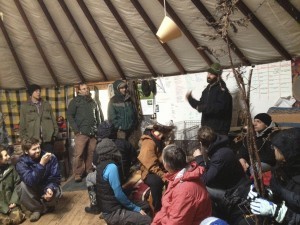
Charles Williams gives us instruction--inside the yurt while the rain pounds down!
We began inside, then moved out when the sun came out!
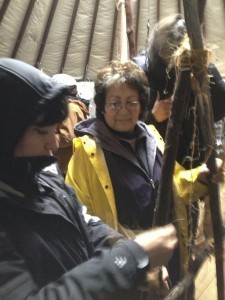
Tying the A-frame together.
Erik Ohlsen, of Permaculture Earth Artisans, a brilliant young designer and teacher, was our guest on several days. Here he shows us the best use of a swale:
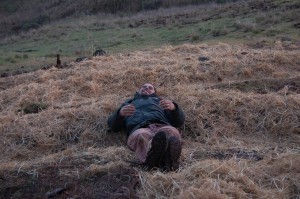
The designer is the recliner!
Our EAT administrator, Susan Park, is handy with a pickaxe as well as a computer!
But it’s not all digging ditches! We took a field trip to Erik’s amazing model permaculture homestead in Sebastopol:
He had them literally hanging from the rafters–or at least, the trees!
Katrina Zavalny, who came and presented on her work greening big corporations, like Disney, helped Erik illustrate the seven-layer food forest: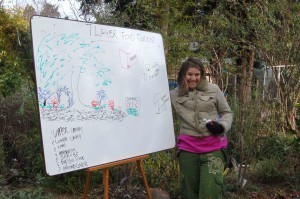
And Erik demonstrates yet again that the designer is the recliner!
From his home, we went on to Erik’s new permaculture ranch and business incubator on the outskirts of Sebastopol–an ambitious and inspiring project!
The chicken ark:
Uh-oh–Carmen is pursued by a stalker!
Brandy runs the Girls2000 Program for Hunters Point Family back in San Francisco–one of the programs Earth Activist Training has helped support for many years. I was so thrilled that she was able to take the course!
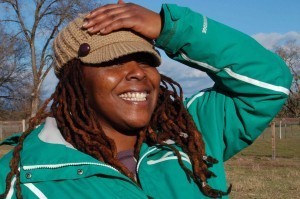 Susan inspects Erik’s keyline plough:
Susan inspects Erik’s keyline plough:
Back home in the hills, we had unusually warm and balmy weather for our second week. We worked on installing an aquaponics system for our greenhouse pond:

Charles supervises onsite!

Many, many loads of gravel!
And our final hands-on was a full day of making cob, brown-coat, natural plaster:
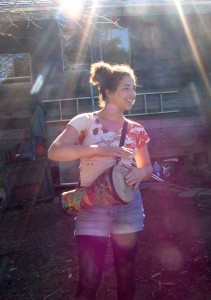
Good cobbing needs drumming--and Naima provides!
And then, finally–design presentation day!
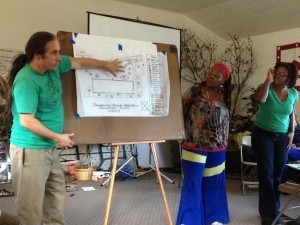
Dave, Brandy and Rushelle present their project.

Lila presents the permaculture design principles.
All the groups did great jobs on their presentations, and all the students graduated with Permaculture Design Certificates! So that’s a little taste of the course–lots of work, lots of fun, lots of learning! We are so deeply grateful to all of you who contributed and made possible this fabulous, diverse and rich experience!
February 13, 2013
My State of the Union
During Obama’s State of the Union message, I was scheduled to give a talk at Northern Arizona University on “Women Taking Action: Using the Insights of the Feminist Movement.” As part of it, I decided to write the State of the Union as if Obama were suddenly possessed by the spirit of the nurturing, caring, life-sustaining values that women have often carried. Here it is—you can compare his speech and see how well he measures up! I am indebted to astrologer Caroline Casey, the brilliant host of the Pacifica radio show Visionary Activist, with whom I spent much of the weekend at the Conscious Life Expo in L.A., for the phrase “until now!” She uses it as a mantra when people get all caught up in how bad it is and how wrong we all are and how doomed we are—she just adds “until now!” Try it when you get caught in a downward vortex!
My sisters, brothers, frères and countryfolk,
The State of the Union is not well. We have defined aggression as strength and poured our resources into killing, starving everything that serves and supports life. We have served the greedy at the expense of the needy, allowed children to go hungry, the poor to lack shelter, the sick to lack care, the wounded from our wars to go unhealed, the aged to be abandoned. And we have utterly failed to address the greatest challenge of our age, the destruction of the earth’s climate and the meltdown of our global life support systems.
Until now!
For now we will work together to heal this mess!
We will siphon away money and resources from war and death to life, to health care and education that inspires and empowers, to arts and imagination and invention and research, to the protection and regeneration of our wildlands and farmlands, to things that enrich our lives and help us to thrive. No longer will we meet the dangers of the world with brute force and firepower—but instead we will look at the causes of violence and change the conditions that breed hate.
Now we will feed the hungry and house the homeless, care for the sick and the wounded, assure the comfort and the security of the elders, because that’s what decent people do. And if our society can’t do this, it’s not worth protecting.
We will cease rewarding greed. Those who benefit from the system will now pay their fair share to support it. We will change the laws that in the past have allowed them to control it, and return power to the people. And—here I’m speaking to the 1%—you know what? Your lives will actually be better. You might have somewhat less stuff but richer relationships, less control but more time, more sense of wonder, more peace of mind. And if you really need it, we’ll name some bridges after you and let you cut some ribbons and open some health care clinics and child care centers, just like the Queen of England.
Most importantly, we’re going to address the destruction of the living systems of the planet. No longer will we allow practices that imperil our climate or our aquifers, or threaten to release radioactive poison over the land. We know that we must make big changes: in our energy systems, our technology, our economy, our food growing systems, our ways of living. But we also know that together, we can do this! We can work together and make the shift to a new world in balance with nature.
We already have the technologies we need—solar, wind, renewables. We can make the transition wisely and swiftly. And we will invest in the research that will bring a thousand new ideas into production, using the resources we still have to create what we need for the new world.
We will protect our forests and wild lands, our arctic wastes and our desert refuges. This year we will plant millions of trees, to suck up carbon and to provide shade and habitat, fruit and nuts, wood and mulch, quiet and beauty.
We will nurture our soil, for building healthy organic soil is the best and fastest way to broadly and safely sequester carbon. That soil will grow healthy food close to where we live, creating true abundance. We will support our farmers to make the transition to humane, organic agriculture, and support our young people to connect to land, to start urban farms and schoolyard gardens, to plant groves of fruit trees and food forests, to grow true abundance for us all.
We will root our industries and enterprises back into local communities. No longer will we subsidize, with cheap fossil fuels and tax breaks, their flight to faroff places with the cheapest labor and the most lax environmental and safety standards. Instead we will demand that they provide for real needs in ways that assure lives of dignity and security to those who do the work. We’re redesigning our cities so that people can live and work, learn and enjoy their pleasures in true community.
We can do this—and more! Imagine how it will be, next year and in years to come, when I can stand before you and say:
This is the State of our Union—we have fed the hungry, cared for the sick, comforted the aged, restored the homeless to their homes, sent our young people forth into life well-educated and debt-free, built thousands of acres of healthy soil, planted a billion trees. We are still challenged by the results of generations of degradation, but we have turned the corner. We’re well on track to an energy-rich world of 100 percent renewables. We’re happier, healthier, more creative, more inventive, safer and more secure. And most of all, we have that wonderful feeling of unity and enthusiasm that comes when we work together.
God—Goddess, Creator, Great Spirit—whatever you want to call it, including our collective human power—bless this great country, and blessed be you all!
December 20, 2012
Winter Solstice 2012
Winter Solstice 2012—it’s here! Tonight is Solstice Eve, and I’ll be dancing around a bonfire at the beach, then keeping an all night vigil at home, then singing the sun up tomorrow at dawn. The old candlewax is scraped out of the candleholders, and the yeast and flour are ready for our midnight bread-baking.
This Solstice seems especially portentous. It’s the ending of the Mayan Calendar, a 30,000 year cycle—though not the end of the world! Yet this year has felt apocalyptic, with floods and drought, mega-storms and horrific massacres—the ones the media pays attention to and the ongoing violence of drones and wars and Occupation that go ignored. We know the climate is changing, we sense great forces contesting for the future. Either we make the deep shifts in our ways of living and working, succeed in what Johanna Macy calls The Great Turning, or we confirm our long, slow, deadly decline.
Solstice represents hope and regeneration. Out of the longest night, a new day is born. The deepest darkness gives birth to light. Tonight, we can draw on that tide of energy and weave some magic for the transformation.
Some of you may already be on your way to join in ceremonies at Mayan temples or jungle retreats. Others may be dusting off your altars, or looking for a ritual to join.
But maybe some of you don’t have a spiritual community. Perhaps you are feeling that you want to do something, and yet don’t know what it might be. Here’s some ideas, and any time over the next few days, between the 20th and 23rd, is a good time to do them.
Solstice can be a time for personal work, for letting go of inner pain, regrets, mistakes, blocks. Fire and water can both be good tools for doing this. Stir some salt into a bowl of water. Sit with it, and let the painful feeling arise, and as they do, breathe them into the water, stirring counterclockwise. When you feel the wave of emotion has passed, sit for a moment and allow yourself to believe that change is possible. Imagine it as a spark of light, that begins to grow as you stir clockwise. You can sing or chant or breathe to raise the energy. When you feel the bowl is glowing, take a small sip and consciously take back the transformed energy. Look back at some of the situations that have been painful and imagine how you might do them differently.
If you have a fireplace or woodstove or a way to make a fire outside, you can do a similar cleansing with fire. Sit by the unlit fire, draw or write your regrets on paper, then light the fire and let them burn up in the flames.
Solstice is also a time to honor the cycles, the seasons and the elements. You don’t have to be at an ancient pyramid to watch the sunset or to gather with friends at dawn and sing up the morning sun.
And Solstice is a time for connection, with friends, family, children and community. Gather with friends and create a feast, and take time for each person to name their hopes for the new era as you raise a glass or pour a libation, and to commit to something they will do to help midwife it into birth. At my house, we like to bake bread, kneading in our dreams and visions. The rising dough is like the swelling belly of the Great Mother, pregnant with the New Year Child. At dawn, the bread is ready, and we bring it up to the hill, still warm, to eat as the sun rises.
And Solstice is a time for magic—for linking our intentions with symbols and images that channel energy to bring them about. Symbolically, the Great Mother goes into labor tonight, to bring forth the Child of Light, the new sun, the new era, the new day. We support her efforts with our gatherings, our chants, our songs, our ceremonies, and the real work we each do, our own labors toward the Great Turning. Change always requires sacrifice—letting go of something, if only our old, destructive ways of being. But every loss, every emptiness, opens the way for something new to be born. In darkness, the seed takes root and the new sprout pushes toward the light. In the dark of the womb, the spark of life is kindled. Out of the longest night, the new day is born.
So let this Solstice be a time when we all put our intention toward the change, and draw forth the strength, the courage and the determination to bring that new world into being. A world where we know that we are not separate, but connected, not the masters of the world, but nature’s children, her partners and healers, where the currency we strive for is not money or power, but love. We are creative, magical, radiant beings, and when we link our hearts, our vision and our actions together, as the Wheel of the Year turns, we can indeed turn the world around.
A blessed Solstice to you all!
Reclaiming is the Pagan/Wiccan tradition I work with, to find out if there is a Reclaiming ritual near you, go here:
http://www.reclaiming.org/worldwide/i...
More information on magic, ritual and Solstice celebrations can be found in my many books, especially:
The Spiral Dance: A Rebirth of the Ancient Religion of the Great Goddess
And Circle Round: Raising Children in Goddess Tradition, with Anne Hill and Diane Baker.
Find them here or ask your local bookstore to order them, or order them from any online bookseller.
Also check out the audiobook Earth Magic, available on Itunes.
December 18, 2012
I Feel So Much Safer Now!
I feel so much safer now, don’t you? Now that so many states are allowing teachers to bring guns to school! High time! Why just yesterday I took little Emmie to kindergarten for her very first day. She looked so adorable with her pink-enameled Baby Browning packed into her Hello Kitty holster. I felt so proud!
I slung my Remington over my shoulder—it’s only a semi-automatic but I didn’t want to be overdressed. Pulled up in the Hummer and noted with a sigh of relief that the entranceway was fully covered by the George Zimmerman Honorary Militia Unit Number 101. Emmie was a little shy but relaxed completely as we walked up the allee of AK 47s keeping us protected from any harm. Those militia guys are so sensitive—using their silencers to avoid upsetting the children when, for example, just behind us they dropped little Shondel from next door in his tracks when he asked, “Why you got that big gun?” Alas, his mother didn’t take it well and began wailing hysterically, even though the nice militia man explained to her that he’d just saved her from the budding terrorist she was nurturing in her bosom. But you know those people have a hard time listening to reason, so he shot her too, in self-defense, of course. How glad I am that we can stand our ground!
The Principal, Mrs. Malice, met us with a warm hug, clasping little Emmie to her bosom with a Wilson combat fixed-blade in one hand and an Uzi in the other. Then we made our way down the hallway, careful to step around a few stray corpses, nothing to worry about really, just a bit of malfunction in the settings for the drones that patrol during class. You won’t be so quick to sneak out to the bathroom without your hall pass with these babies cruising!
We entered the classroom. Miss Grudge, Emmie’s new teacher, gave her a big smile and a playful burst-in-the-air from her classic Thompson sub-machine gun. So high-spirited, yet I could tell by her Glock in the shoulder holster and the classic Colt 45 on the desk that she has a no-nonsense, serious side. The little kiddies were having a fun game of target practice with their pint-sized Smith & Wessons, so good for their hand-eye coordination! And Miss Grudge is such a creative teacher. She really knows how to spot the teaching moment—like after little Billy shot a couple of toes off by accident, why, all the little children learned to count to eight, right there and then!
I left little Emmie for her first day at school, my mind at ease knowing she was well-protected from any crazed terrorists or evildoers who might threaten her life or her freedom!
Truly, the only downside that I can see to our new weapons policy is the little incident in the State Legislature when Senator Avarice introduced the new pension reform bill. The gallery was packed with teachers and after he’d been removed in the body bag his cohorts took one look at that bristling battery of gunbarrels and rapidly voted all educators a hundred percent raise plus full medical and dental benefits and a generous life insurance plan. Surprising how much less we hear these days about state employees and their bloated entitlements.
America’s teachers—best armed, best paid!
November 7, 2012
Now That The Election is Over…
I wake this morning with a profound sense of gratitude. The election is finally over, and Obama has won a second term. As well, although there were some big disappointments in the night, and some key things still in doubt, many good things happened. Elizabeth Warren won a Massachusetts Senate seat, giving us a strong progressive voice in the Senate. Gay marriage won in at least two states, and it was a great night for marijuana, and not just for what you had to smoke to get through the evening! Now you could do that legally in Colorado and Washington state!
What does an Obama victory mean for progressives, greens, anarchists and radicals far, far to his left? To those folks who couldn’t morally bring themselves to vote for Obama, or possibly even to vote at all? Who grew furious at me for urging people to get to the polls and admitting that I voted for him?
I say it’s a good thing. No, Obama won’t enact the policies we want. For one thing, he’s not an absolute monarch and he still has to contend with a Republican Congress. For another, even though he won’t run again in four years, some other Democrat will and they will still need big bucks to do it. Complaining that politicians are tools of the corporations is like complaining that your sheep have wool. Unless we change this system, that’s the nature of the beast.
So how do we do that? We organize and agitate. We don’t sit back, like many did four years ago, and expect the system to change itself.
But organizing after an Obama victory is like bicycling with the wind at your back, instead of peddling into a stiff head wind. I’ve lived and organized through the victories of Nixon, Reagan, Bush and Bush, and believe me, this is better!
And we have a lot of organizing to do. Last year, Occupy Wall Street galvanized the country and put the issue of economic inequality front and center. Had that not happened, we might have seen an election where all the debates centered on how best to reduce the deficit and what more services we could cut. Let’s give three big cheers for Occupy Wall Street—who right now are valiantly doing relief work in parts of New York City hard-hit by Hurricane Sandy. Read about their efforts here: http://www.alternet.org/occupy-wall-street/how-occupy-sandys-relief-machine-stepped-post-superstorm-void?paging=off
Now we need to focus a similar spotlight of attention on climate change, the most crucial and least-addressed challenge of our times. Never again can we have presidential debates that don’t even mention the issue, where the candidates outdo each other to prove how much coal and oil production they can take credit for. Obama has done some good things on the issue, notably pushing the auto industry to adopt more fuel efficiency standards and allowing the EPA to regulate carbon. He could and must take much bolder leadership on moving us onto a new path. He won’t do that in a political climate where a Romney can credibly utter the phrase ‘green energy’ as if it were a dirty word.
We need to push much, much harder, to make it not only politically feasible but vital for him and others to stand up against the biggest of big money issues. 350.org has been doing stellar work, but they need far more support and we need a wide spectrum of efforts that will make it impossible for politicians to dodge the issue. And we need a clear grasp of the solutions—which do exist! Here it is in a sentence: conservation, efficiency, a shift to safe renewables, relocalization, and carbon sequestration in healthy, organic soil the way nature has done it for hundreds of millions of years with a device called ‘plants’. I’ll say more about this in some future post, but for now, know that the spectrum of solutions to climate change are also solutions to our economic, social and health woes. They involve three c’s: community, connection, and compost—all things which will make our lives better in many, many ways!
There are other key issues we need to push Obama and all the politicians on. Economic equality should remain high on our list. Obama has supported egregious assaults on civil liberties, and all of you who complain about that are quite right. And peace—we’ve got to press him to get us out of our endless wars, stop his program of assassination and to bench the drones that kill children and civilians. There’s a lot to do! Check out Juan Cole’s wish list:
http://rsnorg.org/opinion2/277-75/14409-top-ten-wish-list-for-president-obama.
So, for those of you who see Obama as just the cuter, browner face of corporate control, here’s my advice. First, drop the bile, if you can. It’s not attractive, it doesn’t win over those in the confused center who vote against their own interests, and it’s bad for your brain chemistry. Can we make civility the new vitriol, please?
Then take that churning, burning, bottled-up energy and do something with it. Decide what you’re most angry and bitter about, and work on the issue. Join a group or start one. Write letters to the editor or sit in trees—just earn every hour of complaining with an equal hour of organizing.
And look around at the next meeting of your ideologically pure affinity group. If it doesn’t look as diverse as the crowd celebrating Obama’s victory last night, start asking why, and how you might respectfully build a broader, if less pure, coalition. What are the priorities of the communities of color, of immigrants, of the economically marginalized and politically disenfranchised in your area, and how might you offer service?
Okay, first take the day off. Maybe the week. We all need a bit of a break, here. But don’t take the month or the year or the next four years off. Elections are the smallest part of what we need to do to change the world. The real work is up to us.
November 5, 2012
Elections 2012: Lessons from Katrina
“I’m not inspired to vote,” she says. “Everyone I know is voting out of fear, not inspiration.”
I’m in Chicago for their first-ever Bioneers conference, and the beautiful, clear-eyed, curly-haired young woman before me has just told me that my previous blog inspired her to register. She can’t know how gratified I feel, hearing that. As a writer, you hope you influence people, but rarely do you get direct confirmation.
As we talk, I think about fear. We denigrate fear, we sneer at the fearful and the cowardly, and fear is definitely an unpleasant emotion to carry, but perhaps fear is actually a fine reason to vote. Fear, after all, is one of the great life-force emotions. Fear arises when we are threatened, and primes us to act. Fear cuts through denial, and gets us up off the couch. It’s a great motivator.
Generally I’m more in favor of hope and vision as motivators, for the long term. But elections are not poetry readings nor religious revivals. Our hopes and visions are inevitably ground down in the mills of pragmatism when electioneering turns to governing. Hope and vision are what we agitate for in the streets, clamor for in our protests and petitions and demonstrations, and build together in our neighborhoods and towns and local communities. Until we make some overarching changes in our larger systems—most notably restraining the influence of big money!—our hopes will always lead to disappointment.
Nonetheless, who and what we vote for, and against, is vitally important. We should be afraid, terribly afraid, of what will happen if the Republicans can claim a mandate for policies that increase economic inequality, hamstring the government from everything positive that it does to help people, denigrate women and deny the reality of climate change.
We’ve just seen one of the biggest storms in history inundate the East Coast. We can expect more. Although climate change was never mentioned in any of the debates, it is the overriding reality that will shape our future and that of our children and grandchildren. We are already seeing its impact, in drought and floods, tornadoes and more frequent and powerful storms.
After Hurricane Katrina, I went down to New Orleans to volunteer. I saw first-hand what happens when all the big systems—the government, FEMA, the National Guard, the Red Cross, were absent or mismanaged. What was up and working was the smaller, self-organized groups like Common Ground Relief, with whom we volunteered, distributing food, setting up a clinic and offering medical care, organizing programs and projects long before the big systems were operating. The experience deepened my faith in self-organization.
But it also showed me its limitations. All of our best efforts were a tiny drop in the flood of need. A hundred, a thousand Common Ground Reliefs could barely have begun to address the extent of the damage. It required a larger system—a system which functioned in the way that government is supposed to function, with the massive resources and organization that could work on a large scale.
And in the months and years following the disaster, Common Ground Relief suffered its own organizational woes. Some of its projects, like the clinic, continued and became ongoing institutions. Many other projects fell short of their potential.
Today, Occupy Wall Street is providing relief in some of the areas of New York. I salute them and honor their willingness to turn their energies and hard-learned organizing lessons to serve the immediate needs of those whom the big systems have neglected.
Yet there is a world of difference between the disaster response under Obama compared to that of the government-hating Republicans. Romney has explicitly proposed dismantling FEMA and turning disaster relief over to the states and to private enterprise. When we consider the prospect of Halliburton and its like profiteering on the pain and suffering of disaster victims in a world where floods and hurricanes and tornadoes are bound to increase, we should tremble with fear.
And so I’ve voted for Obama. I’m in California, a so-called ‘safe state’, and might have voted for Jill Stein, whose policies are much closer to my ideals. But I believe that it’s important that Obama win the popular vote, not just the electoral vote so that the mandate is clear—not for him as a person, but for policies which favor a government that actually works for the majority of people, not just the 1 per cent. I voted for him not because I love him, or believe that he will make it all good, not even because I’d so much rather look at him for the next four years than the slickly-coiffed white guy. I voted for him because I believe that he will move us more in the direction of what I truly want, and create conditions more favorable for all of us to organize, agitate, and ultimately transform this system into something far more just and fair, something that can inspire us.
Still need inspiration? Consider the sixty years women struggled to get the right to vote. Think of those suffragists on hunger strike, force-fed through tubes, lying in rat-infested prisons—they want you to vote! Think of the civil rights workers in the South, risking their lives to register voters, think of the three who were murdered in 1964, Shwerner, Chaney and Goodman. They want you to vote! And think of how damn hard the Republicans are working to stop you and people like you from voting. If they’re pulling out the stops to keep you away from the polling place, don’t make it easy for them! If they don’t want you to vote, there must be a damn good reason for voting!
Check out Van Jone’s latest: “Don’t Just Vote!” It has some great resources.
http://readersupportednews.org/opinion2/277-75/14363-dont-just-vote
And for you Californians, even if you leave the slot for President blank, PLEASE get out there and vote for the incredibly important propositions—here’s my list:
YES on Prop 30—YES on taxing the rich to pay for our crumbling schools and other vital services, like firefighters!
NO on 31—would allow local governments to opt out of state programs, leaving them vulnerable to manipulation by special interests.
NO on 32—which would effectively cut union influence in elections while leaving corporations free to fund their favorites.
NO on 33—an auto insurance industry scam, essentially.
YES on 34—ending the unfair, racist death penalty (and saving us money!)
NO on 35—sounds good to punish human trafficking, but the relevant laws are already on the books and this could penalize sex workers.
YES on 36—rewriting the incredibly unfair three strikes law to let minor offenders out from a lifetime in prison!
YES on 37—YES, YES, YES on labeling genetically modified foods! If you do nothing else, get out and vote for this. Monsanto’s lies, spread by its big bucks, have eroded support for our right to know what’s in our food, and every vote counts!
YES on 39—Holds out of state corporations responsible for taxes on income they make in California.
Yes on 40—maintains our citizens redistricting boundaries.


